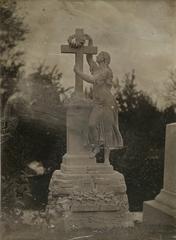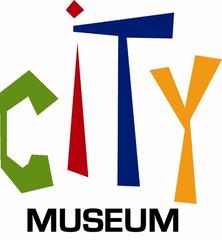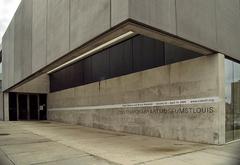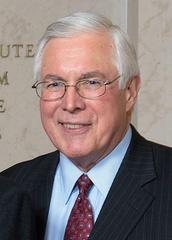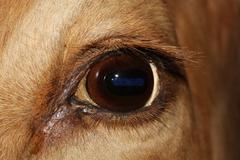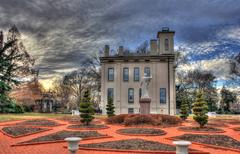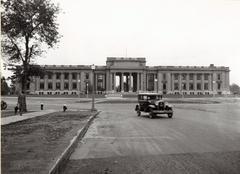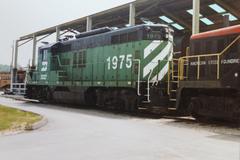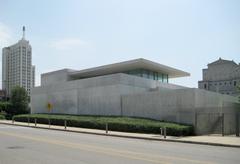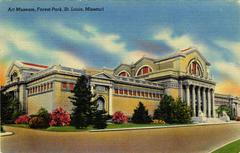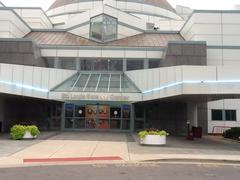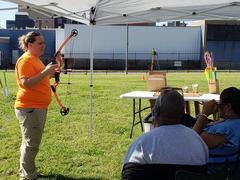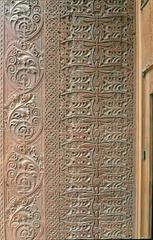Theodore A. Pappas House: Visiting Hours, Tickets, and Historical Significance in St. Louis
Date: 04/07/2025
Introduction
Nestled in the quiet suburb of Town and Country near St. Louis, Missouri, the Theodore A. Pappas House is a remarkable testament to Frank Lloyd Wright’s late-career architectural innovation and his Usonian Automatic design philosophy. Completed in 1964, the home is not only Missouri’s only Usonian Automatic residence but also one of the largest constructed in this uniquely accessible and modern style. Today, the house welcomes visitors for guided tours, offering a rare opportunity to experience Wright’s vision for democratic, beautifully crafted American homes and to learn about the Pappas family’s enduring stewardship (Wikipedia; Midcentury Home; The Clio).
Frank Lloyd Wright’s Vision: The Usonian Automatic Concept
Frank Lloyd Wright’s Usonian Automatic homes were designed as affordable, functional, and aesthetically pleasing dwellings for middle-class Americans. The Pappas House, designed between 1955 and 1959 and built from 1960 to 1964, is a prime example of this vision. Its modular, interlocking concrete blocks could be assembled by homeowners themselves, a feature that drastically reduced both material and labor costs. The Pappas House is one of only two Wright-designed residences in the St. Louis area, and the sole Usonian Automatic in Missouri, with a generous 2,310-square-foot layout featuring four bedrooms (Wikipedia; Midcentury Home; The Clio).
The Pappas Family: Visionaries and Stewards
The Genesis of a Dream
Theodore (“Ted”) and Bette Pappas were inspired by a profound admiration for Wright’s work. Bette’s enthusiasm for Wright’s architecture drove the couple to commission their own Wright-designed home. After reaching out directly to Wright’s studio and meeting the architect at Taliesin, the Pappas family embarked on their journey to build their dream home in what was then rural Town and Country, Missouri (SaveWright).
Building the Home: A Hands-On Endeavor
Construction began in 1960, with Ted and Bette Pappas taking a highly active role—physically building the house alongside day laborers over four years. This approach embodied Wright’s Usonian Automatic philosophy, which envisioned homeowners as co-creators in the construction process (Wikipedia; The Clio).
Family Life and Legacy
The Pappas children grew up in a home defined by natural light, covered walkways, and a sense of spiritual connection to the architecture. Bette Pappas chronicled their experiences in her 1985 book No Passing Fancy. The family’s commitment to the home’s authenticity shaped the house’s preservation for decades (SaveWright; Wikipedia).
Architectural Significance and Preservation
Distinctive Design Features
The Pappas House exemplifies Wright’s principles through its modular concrete block construction, radiant-heated concrete floors, flat roofs with wide cantilevered overhangs, and seamless integration with the landscape. The open-plan, L-shaped layout maximizes privacy and outdoor connection, while custom-built mahogany furnishings and original red concrete floors define the interiors (Midcentury Home).
Recognition and Ongoing Preservation
Listed on the National Register of Historic Places in 1979—an exceptional honor for such a recent structure—the house is recognized for its architectural and cultural significance (Wikipedia; Medium). In 2020, stewardship transitioned to the Frank Lloyd Wright Revival Initiative, which aims to restore, preserve, and eventually transform the house into a museum and educational center (Designed by Frank Lloyd Wright).
Visiting the Theodore A. Pappas House: Essential Information
Location and Access
The house is located at 865 Masonridge Road, Town and Country, MO—about 15 miles west of downtown St. Louis, accessible by car via Interstate 64 or Interstate 270. Public transportation options are limited, so private vehicles or rideshares are recommended.
Visiting Hours and Tickets
Guided tours are available by appointment, typically on select weekends from 10:00 AM to 4:00 PM. All tours require advance booking due to limited group sizes and preservation needs. Tickets cost between $25 and $40 per person, with discounts for students, seniors, and members of architectural organizations. Reservations are required and can be made via the Frank Lloyd Wright Building Conservancy, the FLW Revival Initiative, or the house’s official website.
Children under 12 are generally not admitted.
Accessibility
The main level is partially accessible to wheelchair users, but some narrow passages and steps may present challenges. Visitors with specific mobility needs should inquire ahead of time.
Tour Experience
Tours last 60 to 90 minutes and are led by knowledgeable guides. Highlights include:
- Exploration of the open-plan living and dining areas
- Original built-in furnishings and mahogany woodwork
- The home’s innovative triangular module and block construction
- Connection to the surrounding landscape
Photography is typically restricted inside the home; confirm policies when booking.
Educational Value and Interpretive Content
Docents provide detailed interpretations supported by original blueprints, correspondence, and historic photographs. Visitors will learn about:
- Wright’s organic architecture and Usonian design principles
- Textile block construction and its significance
- Challenges and solutions in historic preservation
- The Pappas family’s story and its contribution to the home’s legacy
Etiquette, Special Programs, and Group Visits
- No food or drink is permitted inside.
- Soft-soled shoes or shoe covers may be required.
- Large bags and backpacks are discouraged.
- Touching surfaces is prohibited to protect finishes.
- Group and educational tours can be arranged in advance, with specialized content available for architecture students and enthusiasts.
Nearby Attractions and Itinerary Suggestions
Enhance your visit by exploring additional local sites:
- Frank Lloyd Wright’s Kraus House (Ebsworth Park) – another Usonian home nearby (ebsworthpark.org)
- Saint Louis Art Museum (slam.org)
- Forest Park – home to museums, gardens, and cultural institutions
Ample on-street parking is available; respect local regulations and neighborhood privacy.
Restoration and Stewardship
Restoration projects focus on preserving original materials and design intent, including:
- Radiant-heated concrete floors
- Mahogany woodwork and custom cabinetry
- Roofing and clerestory windows
- Modernization of mechanical systems when necessary
The house’s ongoing preservation benefits from the technical guidance of the Frank Lloyd Wright Building Conservancy and local craftspeople (Frank Lloyd Wright Building Conservancy).
Frequently Asked Questions (FAQs)
What are the visiting hours?
Tours are by appointment, usually on select weekends from 10:00 AM to 4:00 PM.
How do I purchase tickets?
Tickets must be reserved online in advance via the Frank Lloyd Wright Building Conservancy or the official house website.
Is the house wheelchair accessible?
The main level is partially accessible; inquire about accommodations when booking.
Are children allowed?
Generally, children under 12 are not admitted.
Can I take photographs?
Non-flash photography for personal use is sometimes allowed; commercial photography requires approval.
Conclusion
The Theodore A. Pappas House is an architectural and cultural gem, offering deep insight into Frank Lloyd Wright’s Usonian Automatic philosophy and the passionate stewardship of the Pappas family. Through carefully managed tours and ongoing restoration, the house remains both a living home and a public educational asset. Book your visit in advance, explore nearby attractions, and immerse yourself in the legacy of one of America’s greatest architects.
For the latest updates on tours and events, follow the Frank Lloyd Wright Revival Initiative, download the Audiala app, and stay connected with the Frank Lloyd Wright Building Conservancy.
References
- Frank Lloyd Wright Building Conservancy, Pappas House
- FLW Revival Initiative: Pappas House Tours Announcement
- Midcentury Home: Pappas House
- Wikipedia: Theodore A. Pappas House
- The Clio: Theodore A. Pappas House Entry
- SaveWright: Profound Impact of the Pappas House
- Designed by Frank Lloyd Wright: Pappas House Sale and Restoration
